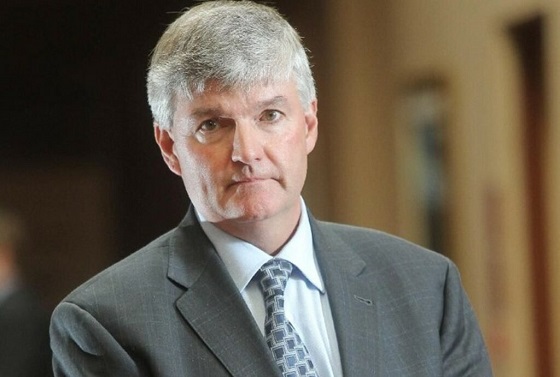Alberta
“The River” water feature chosen by Albertans for the Legislature Grounds
Albertans choose water feature at legislature grounds
Work is underway at the legislature grounds to restore the existing pools and install a new water feature.
Input from nearly 4,000 Albertans in a recent Government of Alberta survey has determined the design of a new water feature for the legislature grounds.
Albertans overwhelmingly supported the design concept “River,” which received more than 65 per cent of the vote.
Here is the announcement from Deputy Premier Nathan Neudorf and Speaker Nathan Cooper:
The survey ran Jan. 12-27 and gave Albertans the chance to choose their favourite of three proposed designs for a new water feature that will be installed at the north plaza of the legislature grounds, replacing the deteriorated terraced wading pools.
Of the other two designs, “Aurora” received 17.1 per cent of the votes followed closely by “Strata” with 17 per cent.
“Thank you to everyone who helped us choose the River design. Nearly 4,000 Albertans responded to the project survey. The feedback and suggestions provided have been crucial in determining the look, feel and future use of this part of our legislature grounds. Your input helps ensure that Alberta’s legislature and grounds will continue to be a destination for Albertans and visitors alike.”
“Alberta’s legislature and grounds are a gathering place for Albertans and visitors from all walks of life. Thanks to this project, the north plaza will have a great new gathering place to enjoy in the summer months. Thank you so much to everyone who took time to submit their feedback. I cannot wait until the new features open in 2024!”
Removing the terraced wading pools and installing the new River area will be part of a larger project to refurbish the water features and improve the north plaza.
Project work at the north plaza is underway and is expected to be completed in 2024.
Quick facts
- The dome fountain and reflecting and wading pools have been closed to the public since 2020 due to the COVID-19 pandemic and mechanical system and public safety issues.
- $20 million is being invested into renewing or replacing the water features and walkways on the Alberta legislature grounds:
- $10 million through the Alberta government’s Budget 2022 Capital Plan
- $10 million through the Investing in Canada Infrastructure Program (ICIP), with $8 million from the Government of Canada and $2 million from the Alberta government
- The Jan. 12- 27 survey posted to alberta.ca received 3,663 responses to the question: Do you have a preferred North Plaza design concept?
- River – 2,413 votes
- Aurora – 628 votes
- Strata – 622 votes
- Reasons Albertans chose the River concept include:
- tranquility
- natural materials
- use of planting/landscape for colour
- more green space, less concrete
- shade provided by trees
- continuous flowing water
- maintained site lines of legislature building
- accessible water animation
- Repairs will be made to the reflecting pool and ornamental dome fountain, replacing piping, updating mechanical and filtration systems, and fixing leaks. The cracked and weathered concrete decking and walkways around all the water features will be replaced. The water barrier on top of the 97 Avenue underpass will also be replaced with a new membrane.
Alberta
Alberta government should create flat 8% personal and business income tax rate in Alberta

From the Fraser Institute
By Tegan Hill
If the Smith government reversed the 2015 personal income tax rate increases and instituted a flat 8 per cent tax rate, it would help restore Alberta’s position as one of the lowest tax jurisdictions in North America
Over the past decade, Alberta has gone from one of the most competitive tax jurisdictions in North America to one of the least competitive. And while the Smith government has promised to create a new 8 per cent tax bracket on personal income below $60,000, it simply isn’t enough to restore Alberta’s tax competitiveness. Instead, the government should institute a flat 8 per cent personal and business income tax rate.
Back in 2014, Alberta had a single 10 per cent personal and business income tax rate. As a result, it had the lowest top combined (federal and provincial/state) personal income tax rate and business income tax rate in North America. This was a powerful advantage that made Alberta an attractive place to start a business, work and invest.
In 2015, however, the provincial NDP government replaced the single personal income tax rate of 10 percent with a five-bracket system including a top rate of 15 per cent, so today Alberta has the 10th-highest personal income tax rate in North America. The government also increased Alberta’s 10 per cent business income tax rate to 12 per cent (although in 2019 the Kenney government began reducing the rate to today’s 8 per cent).
If the Smith government reversed the 2015 personal income tax rate increases and instituted a flat 8 per cent tax rate, it would help restore Alberta’s position as one of the lowest tax jurisdictions in North America, all while saving Alberta taxpayers $1,573 (on average) annually.
And a truly integrated flat tax system would not only apply a uniform tax 8 per cent rate to all sources of income (including personal and business), it would eliminate tax credits, deductions and exemptions, which reduce the cost of investments in certain areas, increasing the relative cost of investment in others. As a result, resources may go to areas where they are not most productive, leading to a less efficient allocation of resources than if these tax incentives did not exist.
Put differently, tax incentives can artificially change the relative attractiveness of goods and services leading to sub-optimal allocation. A flat tax system would not only improve tax efficiency by reducing these tax-based economic distortions, it would also reduce administration costs (expenses incurred by governments due to tax collection and enforcement regulations) and compliance costs (expenses incurred by individuals and businesses to comply with tax regulations).
Finally, a flat tax system would also help avoid negative incentives that come with a progressive marginal tax system. Currently, Albertans are taxed at higher rates as their income increases, which can discourage additional work, savings and investment. A flat tax system would maintain “progressivity” as the proportion of taxes paid would still increase with income, but minimize the disincentive to work more and earn more (increasing savings and investment) because Albertans would face the same tax rate regardless of how their income increases. In sum, flat tax systems encourage stronger economic growth, higher tax revenues and a more robust economy.
To stimulate strong economic growth and leave more money in the pockets of Albertans, the Smith government should go beyond its current commitment to create a new tax bracket on income under $60,000 and institute a flat 8 per cent personal and business income tax rate.
Author:
Alberta
Province to stop municipalities overcharging on utility bills

Making utility bills more affordableAlberta’s government is taking action to protect Alberta’s ratepayers by introducing legislation to lower and stabilize local access fees. Affordability is a top priority for Alberta’s government, with the cost of utilities being a large focus. By introducing legislation to help reduce the cost of utility bills, the government is continuing to follow through on its commitment to make life more affordable for Albertans. This is in addition to the new short-term measures to prevent spikes in electricity prices and will help ensure long-term affordability for Albertans’ basic household expenses.
Local access fees are functioning as a regressive municipal tax that consumers pay on their utility bills. It is unacceptable for municipalities to be raking in hundreds of millions in surplus revenue off the backs of Alberta’s ratepayers and cause their utility bills to be unpredictable costs by tying their fees to a variable rate. Calgarians paid $240 in local access fees on average in 2023, compared to the $75 on average in Edmonton, thanks to Calgary’s formula relying on a variable rate. This led to $186 million more in fees being collected by the City of Calgary than expected.
To protect Alberta’s ratepayers, the Government of Alberta is introducing the Utilities Affordability Statutes Amendment Act, 2024. If passed, this legislation would promote long-term affordability and predictability for utility bills by prohibiting the use of variable rates when calculating municipalities’ local access fees. Variable rates are highly volatile, which results in wildly fluctuating electricity bills. When municipalities use this rate to calculate their local access fees, it results in higher bills for Albertans and less certainty in families’ budgets. These proposed changes would standardize how municipal fees are calculated across the province, and align with most municipalities’ current formulas.
If passed, the Utilities Affordability Statutes Amendment Act, 2024 would prevent municipalities from attempting to take advantage of Alberta’s ratepayers in the future. It would amend sections of the Electric Utilities Act and Gas Utilities Act to ensure that the Alberta Utilities Commission has stronger regulatory oversight on how these municipal fees are calculated and applied, ensuring Alberta ratepayer’s best interests are protected.
If passed, this legislation would also amend sections of the Alberta Utilities Commission Act, the Electric Utilities Act, Government Organizations Act and the Regulated Rate Option Stability Act to replace the terms “Regulated Rate Option”, “RRO”, and “Regulated Rate Provider” with “Rate of Last Resort” and “Rate of Last Resort Provider” as applicable. Quick facts
Related information |
-

 Brownstone Institute1 day ago
Brownstone Institute1 day agoDeborah Birx Gets Her Close-Up
-

 Alberta1 day ago
Alberta1 day agoCoutts Three verdict: A warning to protestors who act as liaison with police
-

 Justice2 days ago
Justice2 days agoOntario Court of Justice says participants must state their ‘preferred pronouns’ during introduction
-

 Business2 days ago
Business2 days agoTrudeau gov’t pledges $42 million to the CBC to promote ‘independent journalism’
-

 Alberta2 days ago
Alberta2 days agoMaxime Bernier says it’s ‘astounding’ Alberta is ‘pushing’ COVID boosters, tells Danielle Smith to stop it
-

 Business2 days ago
Business2 days agoCanada’s economy has stagnated despite Ottawa’s spin
-

 Alberta1 day ago
Alberta1 day agoAlberta moves to protect Edmonton park from Trudeau government’s ‘diversity’ plan
-

 Energy1 day ago
Energy1 day agoCanada Has All the Elements to be a Winner in Global Energy — Now Let’s Do It






